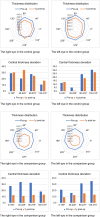Comparison between Surgical Outcomes of LASIK with and without Laser Asymmetric Keratectomy to Avoid Conventional Laser Refractive Surgery Adverse Effects
- PMID: 32591559
- PMCID: PMC7319985
- DOI: 10.1038/s41598-020-67269-y
Comparison between Surgical Outcomes of LASIK with and without Laser Asymmetric Keratectomy to Avoid Conventional Laser Refractive Surgery Adverse Effects
Abstract
This study compared one-year postoperative outcomes of laser refractive surgery combined with laser asymmetric keratectomy (LAK) and laser in situ keratomileusis (LASIK)for myopia correction in middle-aged patients (aged 40-49 years) with a total corneal thickness deviation (summed across four directions) ≥ 80 microns. The control group (n = 26; 52 eyes) underwent LASIK; the comparison group (n = 26; 52 eyes) underwent combined laser refractive surgery and LAK. Age, spherical equivalence, uncorrected visual acuity (near and far), corneal irregularity on the Orbscan map, sum of corneal thickness deviations in four directions, corneal thickness distribution, distance between the maximum posterior elevation (best-fit sphere; BFS) and visual axis, and postoperative blurring scores were analysed retrospectively between the groups. Both groups had similar preoperative findings. Postoperatively, the sum of corneal thickness deviations in four directions (p = 0.000), distance between maximum posterior elevation (BFS) and visual axis (p = 0.003),blurring score (p = 0.001), and corneal irregularity in the 3.0 and 5.0 mm zones on the Orbscan map (p = 0.033 and p < 0.0001, respectively) were significantly lower in the comparison group (p = 0.000). LAK reduced total corneal thickness deviation, improved corneal symmetry, and reduced blurring scores significantly, one-year postoperatively. LAK could resolve shortcomings of LASIK, producing better surgical outcomes.
Conflict of interest statement
The authors declare no competing interests.
Figures




References
-
- Roberts CJ. The cornea is not a piece of plastic. J. Refract. Surg. 2000;16:407–413. - PubMed
Publication types
MeSH terms
LinkOut - more resources
Full Text Sources
Medical

